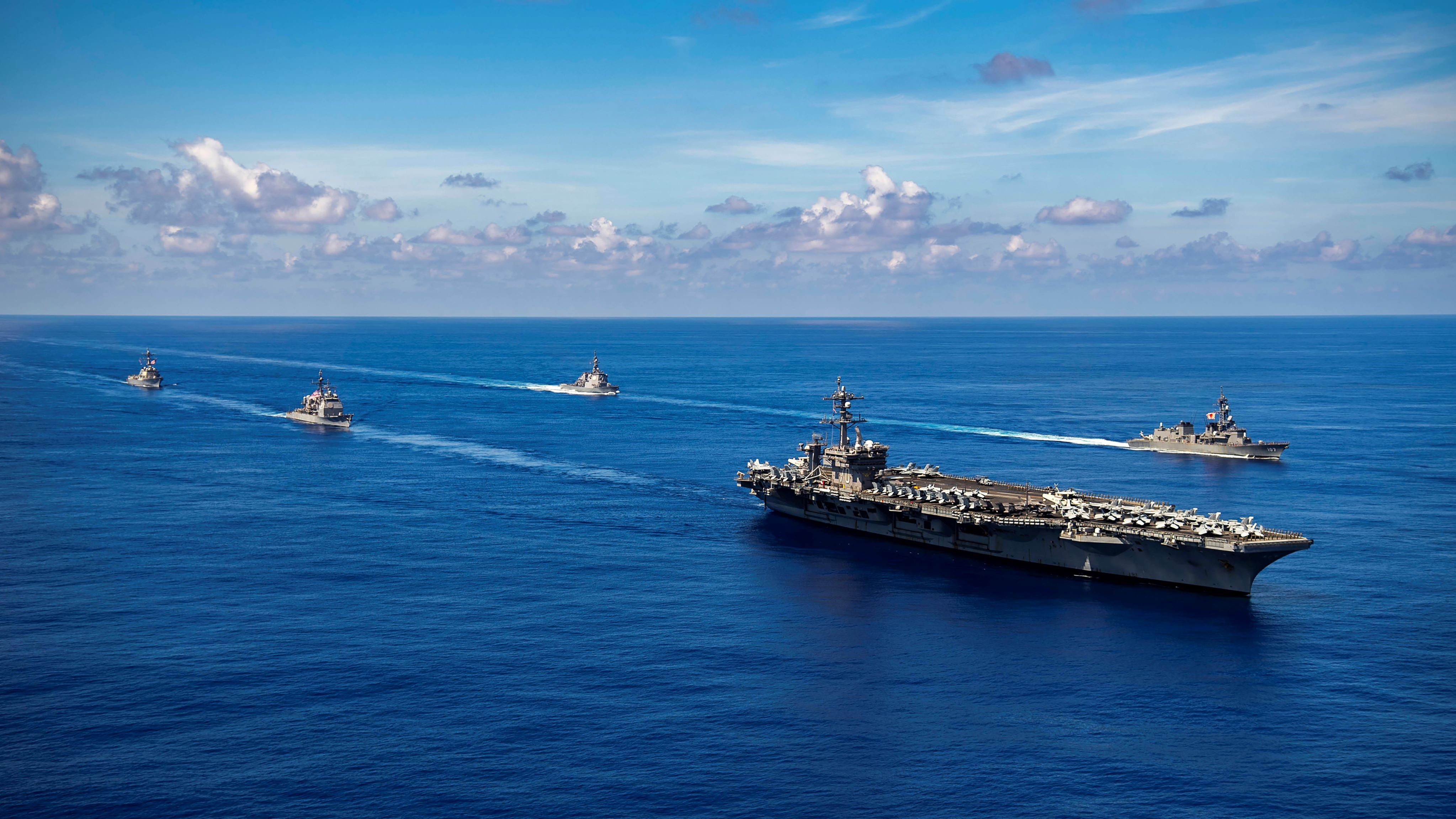The U.S. military is sending assets it can little afford to take out of one critical region to send to another. The Lincoln, which is supposed to be covering the Indo-Pacific, is headed to the Gulf. The USS Dwight D. Eisenhower only just returned to Norfolk, Virginia, after an extended deployment fighting the Houthis in the Red Sea.
It’s something that is likely to continue to challenge the military’s ability to focus on the Indo-Pacific. “This challenges our ability to fully engage the number of assets that we want to have in that part of the world,” said John Miller, a retired U.S. Navy vice admiral who previously served as commander of the U.S. 5th Fleet.
But Miller cautioned that the U.S. military can still move assets around quickly: “We can move air wings from the Air Force between the Pacific and the Middle East. We can move ships between the Pacific or the Atlantic in the Middle East really without a tremendous amount of difficulty for a short period of time.”
Still, “it’s an expensive endeavor, and it’s difficult and time-consuming to replace the assets that we used,” Miller said. “We can’t continue to play this game of defense where it’s half-court lacrosse where we never go on the offensive.”
The Mounting Iranian Threat
The certainty of an Iranian attack on Israel appeared to draw ever clearer over the weekend. On Sunday, U.S. Secretary of State Antony Blinken reportedly warned G-7 leaders that an Iranian strike could begin within 24 hours.
And Iran has been telegraphing its intentions, sending out diplomatic warnings and safety notices. By Monday morning, Iran was issuing a notice to airmen to close off its airspace. The German air carrier Lufthansa canceled flights to Beirut, Tel Aviv, and Tehran. And the United States and other Western countries were urging their citizens to leave Lebanon and other nearby countries as soon as possible.
“This is the typical syndrome of action-reaction,” said Bilal Saab, an expert on U.S.-Middle East security issues with Trends Research and Advisory, a consulting group. “It doesn’t really matter what Iran on its own is going to do—it also matters what the Israelis are going to do in response. I don’t expect the tit-for-tat to completely get out of hand, but at the same time, every time we go through these dynamics, there’s a higher risk of escalation because the targets keep getting a little bit more ambitious.”
The Challenges of Retaliation
Iran has certain obstacles when it comes to launching massive retaliatory strikes against Israel. For one, it has a limited number of launchers, putting bottlenecks in place if it wants to send out a massive cruise and ballistic missile salvo. Iran, of course, can also compensate for Israel’s strategic depth by using its network of proxies—especially Hezbollah—which is right over the border in Lebanon and has a bone to pick with Israeli Prime Minister Benjamin Netanyahu’s far-right government after last week’s airstrike by the Israel Defense Forces that took out Fuad Shukr, a senior Hezbollah commander.
But Israel has also been fighting a war with Hamas in Gaza since Oct. 7, 2023, as well as engaging in near-daily tit-for-tat strikes with a heavily armed Hezbollah since that time, which have together taken a toll on the country’s Iron Dome air defense system. Israel is continuing to try to restock its Iron Dome batteries—with the help of the United States—but some experts fear that an all-out assault from Iran and Hezbollah could overwhelm the system.
“Countries that have ballistic missiles, cruise missiles, and drones are always going to have more of those than the counter-ballistic missile, counter-cruise missile, counter-drone systems that the West has,” Miller said.
If Iran decides to do a cheaper attack—such as by using mostly Shahed drones rather than missiles to hit Israel—the slow-moving unmanned aerial vehicles could be detected by early warning systems and picked off one by one with bullet-to-bullet air defenses.
That’s with help from the region, though. While U.S. allies such as Jordan are more likely to help, Egypt has already publicly stated that it won’t help Israel fend off an attack.
Balancing Competing Priorities
“We are not building a military that can handle three theaters simultaneously,” said Mark Montgomery, a senior fellow at the Foundation for Defense of Democracies.
The U.S. military is sending assets it can little afford to take out of one critical region to send to another. The Lincoln, which is supposed to be covering the Indo-Pacific, is headed to the Gulf. The USS Dwight D. Eisenhower only just returned to Norfolk, Virginia, after an extended deployment fighting the Houthis in the Red Sea.
The need to defend Israel has U.S. military might directed back into the Middle East. And it has left the United States’ already stretched ship crews, fighter squadrons, and air defenses stuck having to cover even more ground.
A Global Balancing Act
The U.S. military is sending assets it can little afford to take out of one critical region to send to another. The Lincoln, which is supposed to be covering the Indo-Pacific, is headed to the Gulf. The USS Dwight D. Eisenhower only just returned to Norfolk, Virginia, after an extended deployment fighting the Houthis in the Red Sea.
It’s something that is likely to continue to challenge the military’s ability to focus on the Indo-Pacific. “This challenges our ability to fully engage the number of assets that we want to have in that part of the world,” said John Miller, a retired U.S. Navy vice admiral who previously served as commander of the U.S. 5th Fleet.
But Miller cautioned that the U.S. military can still move assets around quickly: “We can move air wings from the Air Force between the Pacific and the Middle East. We can move ships between the Pacific or the Atlantic in the Middle East really without a tremendous amount of difficulty for a short period of time.”
Still, “it’s an expensive endeavor, and it’s difficult and time-consuming to replace the assets that we used,” Miller said. “We can’t continue to play this game of defense where it’s half-court lacrosse where we never go on the offensive.”
A Difficult Balancing Act
The certainty of an Iranian attack on Israel appeared to draw ever clearer over the weekend. On Sunday, U.S. Secretary of State Antony Blinken reportedly warned G-7 leaders that an Iranian strike could begin within 24 hours.
And Iran has been telegraphing its intentions, sending out diplomatic warnings and safety notices. By Monday morning, Iran was issuing a notice to airmen to close off its airspace. The German air carrier Lufthansa canceled flights to Beirut, Tel Aviv, and Tehran. And the United States and other Western countries were urging their citizens to leave Lebanon and other nearby countries as soon as possible.
“This is the typical syndrome of action-reaction,” said Bilal Saab, an expert on U.S.-Middle East security issues with Trends Research and Advisory, a consulting group. “It doesn’t really matter what Iran on its own is going to do—it also matters what the Israelis are going to do in response. I don’t expect the tit-for-tat to completely get out of hand, but at the same time, every time we go through these dynamics, there’s a higher risk of escalation because the targets keep getting a little bit more ambitious.”
A Balancing Act in a Volatile Region
Iran has certain obstacles when it comes to launching massive retaliatory strikes against Israel. For one, it has a limited number of launchers, putting bottlenecks in place if it wants to send out a massive cruise and ballistic missile salvo. Iran, of course, can also compensate for Israel’s strategic depth by using its network of proxies—especially Hezbollah—which is right over the border in Lebanon and has a bone to pick with Israeli Prime Minister Benjamin Netanyahu’s far-right government after last week’s airstrike by the Israel Defense Forces that took out Fuad Shukr, a senior Hezbollah commander.
But Israel has also been fighting a war with Hamas in Gaza since Oct. 7, 2023, as well as engaging in near-daily tit-for-tat strikes with a heavily armed Hezbollah since that time, which have together taken a toll on the country’s Iron Dome air defense system. Israel is continuing to try to restock its Iron Dome batteries—with the help of the United States—but some experts fear that an all-out assault from Iran and Hezbollah could overwhelm the system.
“Countries that have ballistic missiles, cruise missiles, and drones are always going to have more of those than the counter-ballistic missile, counter-cruise missile, counter-drone systems that the West has,” Miller said.
If Iran decides to do a cheaper attack—such as by using mostly Shahed drones rather than missiles to hit Israel—the slow-moving unmanned aerial vehicles could be detected by early warning systems and picked off one by one with bullet-to-bullet air defenses.
That’s with help from the region, though. While U.S. allies such as Jordan are more likely to help, Egypt has already publicly stated that it won’t help Israel fend off an attack.

















